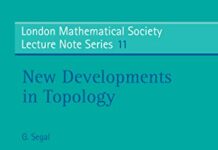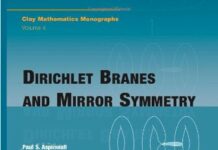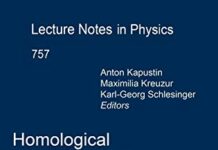
Ebook Info
- Published: 2009
- Number of pages: 681 pages
- Format: PDF
- File Size: 4.08 MB
- Authors: and P.M.H. Wilson Paul S. Aspinwall, Tom Bridgeland, Alastair Craw, Michael R. Douglas, Mark Gross, Anton Kapustin, Gregory W. Moore, Graeme Segal, Balazs Szendroi
Description
Research in string theory over the last several decades has yielded a rich interaction with algebraic geometry. In 1985, the introduction of Calabi-Yau manifolds into physics as a way to compactify ten-dimensional space-time has led to exciting cross-fertilization between physics and mathematics, especially with the discovery of mirror symmetry in 1989. A new string revolution in the mid-1990s brought the notion of branes to the forefront. As foreseen by Kontsevich, these turned out to have mathematical counterparts in the derived category of coherent sheaves on an algebraic variety and the Fukaya category of a symplectic manifold. This has led to exciting new work, including the Strominger-Yau-Zaslow conjecture, which used the theory of branes to propose a geometric basis for mirror symmetry, the theory of stability conditions on triangulated categories, and a physical basis for the McKay correspondence. These developments have led to a great deal of new mathematical work. One difficulty in understanding all aspects of this work is that it requires being able to speak two different languages, the language of string theory and the language of algebraic geometry. The 2002 Clay School on Geometry and String Theory set out to bridge this gap, and this monograph builds on the expository lectures given there to provide an up-to-date discussion including subsequent developments. A natural sequel to the first Clay monograph on Mirror Symmetry, it presents the new ideas coming out of the interactions of string theory and algebraic geometry in a coherent logical context. We hope it will allow students and researchers who are familiar with the language of one of the two fields to gain acquaintance with the language of the other. The book first introduces the notion of Dirichlet brane in the context of topological quantum field theories, and then reviews the basics of string theory. After showing how notions of branes arose in string theory, it turns to an introduction to the algebraic geometry, sheaf theory, and homological algebra needed to define and work with derived categories. The physical existence conditions for branes are then discussed and compared in the context of mirror symmetry, culminating in Bridgeland’s definition of stability structures, and its applications to the McKay correspondence and quantum geometry. The book continues with detailed treatments of the Strominger-Yau-Zaslow conjecture, Calabi-Yau metrics and homological mirror symmetry, and discusses more recent physical developments. This book is suitable for graduate students and researchers with either a physics or mathematics background, who are interested in the interface between string theory and algebraic geometry.
User’s Reviews
Reviews from Amazon users which were colected at the time this book was published on the website:
⭐Giving a fairly detailed overview of mirror symmetry that emphasizes both its mathematical and physical aspects, this book should be accessible to readers who are familiar with topological quantum field theory, superstring theory, and the highly esoteric mathematical constructions used in these fields. The authors do not always explain everything they write down in the book, but by consulting the many references the omissions can be filled in if time is not a severe constraint. There are several important ideas and concepts needed to understand the content of this book, and some of the main ones include:1. Abelian categories and derived categories: For a complex in an Abelian category, there is a notion of kernel and cokernel, which may not exist in a general category. Readers will have to know category theory fairly well to appreciate why non-Abelian categories are more difficult to work with. If A is an Abelian category the quasi-morphisms become isomorphic. In a derived category the morphisms do not have kernels or cokernels, and so they are ‘additive’ but not Abelian. In the homotopy category for example it is difficult to say when a sequence of morphisms is exact, and so there is no kernel or cokernel. This implies that there are no short exact sequences, and to compensate for this, ‘distinguished triangles’ of maps are brought in and a way of shifting complexes up and down. The ‘mapping cone’ construction gives a generalization of the kernel and cokernel in the form of an exact triangle of maps between three objects. Between two of these objects, the maps are regular morphisms, while from the third object to one other it shifts the degree of the other object by one. The point is that not all triangles of maps are exact, but that any triangle isomorphic to a distinguished triangle is declared to be exact. Note that the notion of an ‘A-infinity algebra’ can arise here when attempting to show equivalences between triangles of maps. The notion of a t-structure is used to detect different Abelian categories inside a derived category. A bounded t-structure is determined by its ‘heart’. The Poincare bundle induces equivalences between the derived category of an abelian variety and its dual. This can be generalized to the Fourier-Mukai transform, which is very important and is used extensively in this book. Speaking somewhat more formally, in the category of complexes an object and its resolution are not always isomorphic, but the complexes can be altered to repair this defect. This is what derived categories do, and so every time the notion of a sub-object is needed, one can find a replacement that uses only the triangulated structure. A distinguished triangle will not permit the decay of a stable B-brane into two other stable B-branes. In this context, a binding process can be viewed as a formation, wherein two D-branes can bind together via a (potentially) tachyonic open string. The notion of a mapping cone comes from (algebraic) topology, where there is no notion of a kernel or cokernel in the homotopy category of topological spaces. If f: X -> Y is a mapping between spaces with f(X) contained properly in Y, then to deal with this what is done is to identify X x {1} with f(x) and collapse X x {0} to a point. This is called the ‘suspension’, and then the fiber of f will act as a kernel and the collapsed X x {0} acts as a cokernel. One obtains the maps X -> Y -> Y/X -> Susp(X) -> …. , and after taking homology the ith homology group of Susp(X) is the i-1-th homology group of X. Hence the homology shifts in degree by one by taking the suspension. The mapping cone construction in a derived category gives a triangulated structure on the category, which is very important in the notion of D-brane stability, and defines a potential bound state of two D-branes. Fukaya categories may not have a triangulated structure, so there is a need to add “potentially stable” A-branes to the Fukaya category so that it becomes triangulated. In sheaf theory, a similar issue arises in that a surjection of sheaves will not in general be surjective on local sections, i.e. cokernels will not be sheaves, and so one must “sheafify”. However, kernels and cokernels between coherent sheaves will be coherent. This motivates the construction of the bounded derived category of coherent sheaves, with the category of coherent sheaves being a subcategory. The essential philosophy of derived categories is to retain as much as possible the information given in the complexes, i.e. derived categories are supposed to “remember” the information in the entire complex. As an example, if X and Y are simplicial complexes, then they will have homotopy equivalent geometric realizations |X| and |Y| if and only if one can find a simplicial complex Z and maps f: Z -> X, g: Z -> Y such that f*: C(X) -> C(X) and g*: C(Z) -> C(Y) are quasi-isomorphisms, where C(.) denotes the set of complexes. The requirement of quasi-isomorphic is true if and only if f*: Hi(Z) -> Hi(X) and g*: Hi(Z) -> Hi(Y) are isomorphisms for each i. In a derived category then, quasi-isomorphisms are viewed as isomorphisms. The derived category goes beyond K-theory in that it keeps track of all massless fermionic open strings between a pair of D-branes., the latter of which depends on more than the topological class of the branes. The derived category can be motivated from a study of topological open string theory, but wherein the BRST operator is allow to have non-trivial dependence on the Chan-Paton factors and there is an equivalence relation by the identification of configurations which are related by the addition and cancellation of brane/antibrane pairs. This is different from the situation in K-theory, where a brane-antibrane pair cancels if all open strings to them cancel out of the Q-homology, i.e. if the brane and antibrane are identical as holomorphic objects.2. K-theory and twisted K-theory: The K-theory classification classifies the allowed RR field strengths as well as the charges of stable D-branes. Of great research interest but not discussed in too much detail in this book is the connection between K-theory and S-duality. D-branes are in general classified by twisted K-theory, but RR-fluxes are not quite classified by K-theory since the K-theory classification is incompatible with S-duality in Type II-B string theory. In somewhat more detail, to classify fluxes on a compact 10-dimensional space-time must deal with the fact that RR fluxes are self-dual. This implies the use of the Hodge star, which depends on the metric and is continuously valued. Hence it will be generically irrational, conflicting with the fact that Chern characters in K-theory are always rational. Hence the K-theory classification is in trouble here. A natural question to ask here is if a cohomology classification is in anyway tenable since Type II strings in the classical limit is Type II supergravity wherein the RR field strengths are differential forms. But topologically distinct RR field strengths can exist in configurations free of branes, and so the (integral) cohomology is too large. This motivates the “twisting” of the NS 3-form field strength, namely the use of twisted K-theory. This is supposed to classify the subset of RR field strengths that can exist in the absence of D-branes up to equivalence by large gauge transformations. This can be extended to RR potentials using differential K-theory. SUSY-based classifications, i.e. those D-branes carrying BPS charge, do not detect those D-branes with torsion charges (charges conserved modulo N), and these can be captured by using the K-theory classification. Hence one could conclude that the K-theory classification of D-branes is stronger than the classification by BPS states. But D-branes are BPS states and so their mass is completely determined by their charge with respect to some gauge fields. However, there are stable but non-BPS states that exist in the weak coupling regime and they become D-branes at strong coupling.3. Pi-stability: This determines which elements in a derived category actually correspond to physical BPS D-branes. The notion of pi-stability can be viewed as arising when asking whether there is a generalization of the theta- and mu-stability conditions that is valid everywhere in the moduli space but reduces to these conditions in the corresponding limits. This implies the need for D-branes at generic points in moduli space to have “sub” D-branes, which implies the need for a notion of “subobject” of an object in the category of D-branes. An object E’ is a sub-object of an object E if there exists and injective homomorphism from E’ to E. For a point u in the Kahler moduli space, E is ‘pi-semistable’ at u if and only if for every sub-brane E’ of E at u, one has phi(E) is greater than or equal to phi(E’), where phi(E) is related to the central charge Z(E, u). E is ‘pi-stable’ if phi(E) = phi(E’). The notion of pi-stability reduces to theta-stability at orbifold points and mu-stability at the large volume limit, as required. Another way of viewing this is examine the generic category of pi-semistable objects with a fixed grading phi. The “simple” objects of this category will be the pi-stable objects, and it is of interest to know if this category is Abelian or Artinian. If it is not Artinian, then some objects could decay into an infinite number of subjects on the line of marginal stability.4. Quivers: A quiver is a relatively simple object to define and consists of a collection of vertices and arrows, and have representations built on finite-dimensional vector spaces for each vertex, and linear transformations for each arrow. Representations of quivers can be nontrivial to find despite the simplicity of the quiver itself. Near an orbifold point the world volume of D-branes is given by quiver gauge theories and D-brane configurations correspond to representations of quivers which satisfy the F-flatness and D-flatness conditions. These conditions are applicable in the ‘large volume limit’ and for D-flatness depends on the complexified gauge group and the notion of theta-stability (at the orbifold points) and mu-stability (at the large volume limit). If a (quiver) representation is theta-stable then the orbit under the complexified gauge group will contain a solution to the D-flatness conditions. Related to quivers are the famous Kac-Moody algebras in that if Q is a quiver then the set of dimension vectors of indecomposable representations of Q does not depend on the orientation of arrows in Q, and the dimension vectors of indecomposable representations correspond to positive roots of the corresponding root system. The real roots are dimension vectors for which there is exactly one indecomposable representation, whereas the imaginary roots are the dimension vectors for which there are families of indecomposable representations. As expected, quivers form a category (over a given field) and wherein one can take speak of the vertex of a direct sum and the linear transformation of a direct sum of quivers.This review is based on a reading of chapters 3-5 of the book.
⭐
Keywords
Free Download Dirichlet Branes and Mirror Symmetry (Clay Mathematics Monographs) 0th Edition in PDF format
Dirichlet Branes and Mirror Symmetry (Clay Mathematics Monographs) 0th Edition PDF Free Download
Download Dirichlet Branes and Mirror Symmetry (Clay Mathematics Monographs) 0th Edition 2009 PDF Free
Dirichlet Branes and Mirror Symmetry (Clay Mathematics Monographs) 0th Edition 2009 PDF Free Download
Download Dirichlet Branes and Mirror Symmetry (Clay Mathematics Monographs) 0th Edition PDF
Free Download Ebook Dirichlet Branes and Mirror Symmetry (Clay Mathematics Monographs) 0th Edition


